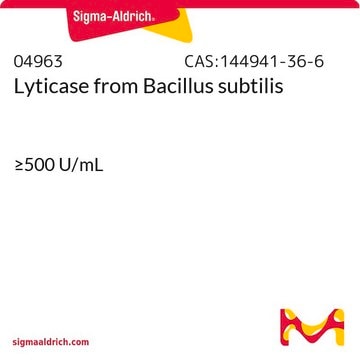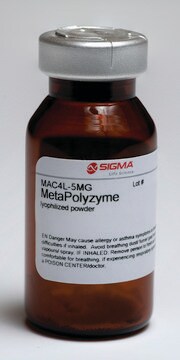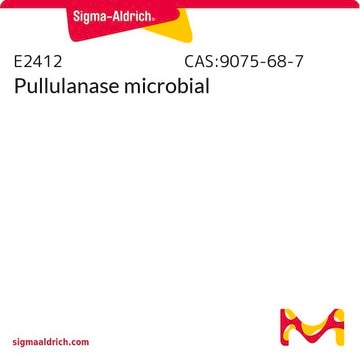L4025
Liticasi
lyophilized powder, ≥200 units/mg solid
Sinonimo/i:
(1,3)-β-D-Glucan endohydrolase, 1,3-β-Glucan glucohydrolase, Bacterial lyticase, Lysing enzyme
Scegli un formato
148,00 €
Scegli un formato
About This Item
148,00 €
Prodotti consigliati
Origine biologica
bacterial (Arthrobacter luteus)
Livello qualitativo
Stato
lyophilized powder
Attività specifica
≥200 units/mg solid
tecniche
cell based assay: suitable
Compatibilità
suitable for cell lysis
applicazioni
diagnostic assay manufacturing
Temperatura di conservazione
−20°C
Cerchi prodotti simili? Visita Guida al confronto tra prodotti
Categorie correlate
Applicazioni
Azioni biochim/fisiol
Definizione di unità
Altre note
Avvertenze
Danger
Indicazioni di pericolo
Consigli di prudenza
Classi di pericolo
Resp. Sens. 1
Codice della classe di stoccaggio
11 - Combustible Solids
Classe di pericolosità dell'acqua (WGK)
WGK 3
Punto d’infiammabilità (°F)
Not applicable
Punto d’infiammabilità (°C)
Not applicable
Dispositivi di protezione individuale
Eyeshields, Gloves, type N95 (US)
Scegli una delle versioni più recenti:
Certificati d'analisi (COA)
Non trovi la versione di tuo interesse?
Se hai bisogno di una versione specifica, puoi cercare il certificato tramite il numero di lotto.
Possiedi già questo prodotto?
I documenti relativi ai prodotti acquistati recentemente sono disponibili nell’Archivio dei documenti.
I clienti hanno visto anche
Protocolli
This procedure may be used for the determination of Lyticase activity using Baker’s yeast as the substrate.
Filtri attivi
Il team dei nostri ricercatori vanta grande esperienza in tutte le aree della ricerca quali Life Science, scienza dei materiali, sintesi chimica, cromatografia, discipline analitiche, ecc..
Contatta l'Assistenza Tecnica.











